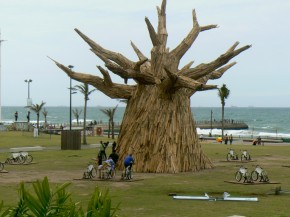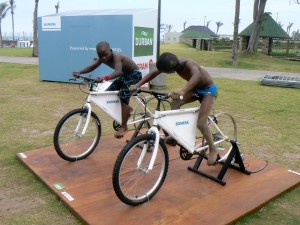The opportunity to attend a COP (Conference of the Parties) event, and one that was hosted in South Africa where I grew up, was a dream come true for me - a once in a lifetime event I won't soon forget. I am still digesting all the information shared at the various 'side events' and associated goings-on I attended, as well as reading up on the developments that were agreed in the extended final hours or in the various working groups. I felt like I was back at university for an intense week. My friends and family were all keen to hear more. I hope I haven't left them scratching their head like the customs official who told me on arrival that, although she had read about it in the newspaper, she was still struggling to know what it was all about or meant. I did find myself using a quote from Obama with friends, that was shared at the event, to help emphasise my point about the energy revolution that was happening and needed, as well as the resource scarcity crunch: "I don't care if you're driving a hybrid or an SUV. If you're headed for a cliff, you've got to change direction".

I loved that the baobab tree was chosen as a logo for COP17. It is sometimes called the 'upside-down tree' or the 'tree of life and gifts'. There was a giant baobab tree erected on the Durban beach front, made from recycled wooden pallets against a metal frame with LED lights fixed to the branches. The public were asked to pedal on cycles next to the tree to light it up! I tried it with a friend – and only got six lights going, but it was my personal favourite energy demonstration event.
It reminded me of the holistic power of nature and to work with that where possible - for example, by replanting forests on hillsides to prevent erosion and mudslides, or protecting mangroves and wetlands that can buffer coastal communities from storm damage. Or to combine with engineered solutions to assist people and nature in preparing for and responding to the disruptions that a changing climate brings.
The baobab tree stems store huge amounts of water to cope with seasonal droughts and Kalahari Bushmen use grass straws to suck the water out of them or chew the bark when thirsty. The branches make ropes and the leaves of the tree are edible. The seeds of the tree can be ground to make coffee and the pollen used as glue. The fruit - 'monkey bread' - is a medicine chest containing tartaric acid, calcium, vitamins C and B. Powdered baobab fruit is now a fair trade sensation and is used as a healthy additive in cereal bars and smoothies. Baboons especially love it too.
It is said that kings, elders and leaders throughout African history held meetings under huge baobabs to discuss matters of great importance. Not only did the trees provide shelter, but the tribal leaders also believed that the spirit of the baobab would help them make wise decisions. I wondered when I left on the Friday, and there was no final outcome yet on the negotiations side, whether the "spirit of the baobab" was managing to guide the delegates to ensure climate justice for all and whether the agreement would go far enough. I was personally keen to see if they would address the gap between the current level of ambitions for emissions reductions and the below-2-degrees goal. Countries will clarify their emissions targets by 5 March 2012, but also submit options for further increasing the level of ambition and possible further actions by 28 February – the latter is critical for small island states. As my counterparts in the region say- there is a limit to adaptation!
One thing is for sure, seeing the thousands gathered to discuss the challenges and seeing how tough the negotiations were through the faces of delegates during coffee breaks, you really come to appreciate the importance of communication mechanisms like this platform. It involves such a broad range of stakeholders, but is necessary to help build understanding and trust and make some progress.

As someone who is involved in assisting the Caribbean region in addressing climate change challenges and mobilising resources to carry out urgent actions identified in their resilience building strategy and plan, I know that work to boost learning and accelerate effective responses is more critical than ever. Given the uncertainty of the threat and the most effective responses for these impacts, we will be learning by doing. A useful take-away checklist for results management from a side event on the evaluation of adaptation was to ensure that we cover these key factors in our efforts:
- Data use: consider a good mix of information sources and processes like community participation to bridge the uncertainty of available climate information
- Adaptation reasoning: consider future climate change against business as usual in terms of magnitude, selection, specifics in the project design
- Project flexibility: make provision for external changes in information and include monitoring so can use the lessons learnt to adjust to changing circumstances
- Behavioural change: create a situation conducive to change and one that motivates communities to adjust their risk exposure through information sharing, evidence or monetary guarantees
- Systematic change: consider effort to influence broader policy and society through demonstrations, awareness raising
- Innovation and learning: seize the potential to share lessons and new ideas
An article entitled Caribbean Ready to Roar was published in an African and World news bulletin, following an interview with Dr Kenrick Leslie – the Executive Director for the Caribbean Community Climate Change Centre – at the COP event. It outlines the regional efforts being made to manage the change, shocks and stresses, and to pursue a low carbon development pathway. It is a good soundbite to end this blog, I think. I hope in some small way I am helping to make it happen - and it is important that we all keep 'roaring' to help save the health, wealth and welfare of the region's people and nature.

2 comments
Comment by Sam Collier posted on
Fantastic stuff! I too love Baobab trees. They look so unique and unreal. I couldn't stop laughing when I saw the kids pedalling so hard to light up the lights on the Baobab tree sculpture. It occurred to me that someone mischievous might be drawing 90% of the power generated to power their home/workplace and send the remaining 10% to the tree sculpture! And pedallers might see only 4 lights are lit up so will try harder and generate more electricity! Genius... if that were the case. I'm sure it's not.
Comment by Evan Green posted on
Wonderful! Keep roaring so all can hear!! All the best